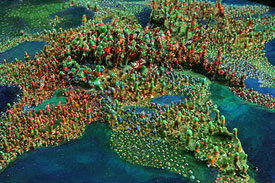 |
| The Hyperbolic Coral Reef project has spread around the globe |
Crochet, a fiber art that traditionally has utilitarian purpose, holds the power to make this mystery visible to our eyes. With this in mind, various hyperbolic coral reef projects have sprung up around the globe, bringing together crochet artists to call attention to the fact that this natural wonder -- something akin to the oceans' natural forest -- is vastly disappearing as a result of pollution, human waste and climate change.
 |
| Photo of satellite reef, Föhr, Germany, courtesy Uta Lenk |
The Hyperbolic Coral Reef Project is the brainstorm of Margaret and Christine Wertheim, who founded the Institute for Figuring in Los Angeles to highlight this phenomenon. They based their idea on the discovery of a mathematician at Cornell University, Daina Taimina. Taimina used crochet to unlock a mathematical means to explain the parallel nature of crochet lines in 1997, while the Wertheims further developed a repetoire of reef-life forms: loopy "kelps", fringed "anemones", crenelated "sea slugs", and curlicued "corals." A simple pattern or algorithm, which has a pure shape can be changed slightly to produce variations and permutations of color and form. The Crochet Reef project began in 2005 and the experiment has involved communities of Reefers, which, like the reef itself, have become worldwide. The Wertheim sisters come from Australia, where the Great Barrier Reef is located, while Taimina is originally from Latvia.
| Photo of Actual Coral Reef, from www.thenowpass.com |
 |
| Postcard from the coral reef project in Föhr, Germany |
This past summer, there was an installation at the Museum Kunst der Westkuste on island of Föhr, in Germany. Over 700 artists from the island, and the mainland of Germany and Denmark came together and contributed to the largest of over 20 worldwide projects around the world. At this moment, there is a satellite of the Hyperbolic Crochet Coral Reef Project at Roanoke College in Salem, Va. It will remain there at the Olin Gallery until March 1, 2013, reminding students at this Liberal Arts College of the fragility of the coral reef.
Artist Elise Richman -- who lives on the Puget Sound and teaches at the University of the Puget Sound in Tacoma, Wa -- also reminds us that changes are afloat at sea. Richman has different processes of painting, each of which reflect environmental systems and states of flux. In the water-based paintings, she applies inks, acrylics and a liquified powder pigment that has been mixed with powder gum arabic. She pours pools of these paints onto thick sheets of watercolor paper, allowing them to expand, evaporate, be absorbed or intermingle, while using minimum control.
 |
| Elise Richman, Each Form Overflows its Present, mixed media on canvas, 2013, photo by Richard Nicol |
 |
| Elise Richman, Isle I, oil, 12 x 12, 2008 photo by Richard Nicol |
 |
| Elise Richman, detail of Pool I, 2010, photo by Richard Nicol |